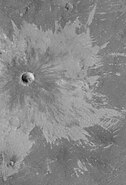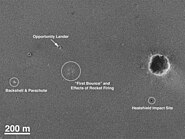Lua error in package.lua at line 80: module 'Module:No globals' not found. Template:Infobox spaceflight Mars Global Surveyor (MGS) was an American robotic spacecraft developed by NASA's Jet Propulsion Laboratory and launched November 1996. Mars Global Surveyor was a global mapping mission that examined the entire planet, from the ionosphere down through the atmosphere to the surface.[1] As part of the larger Mars Exploration Program, Mars Global Surveyor performed monitoring relay for sister orbiters during aerobraking, and it helped Mars rovers and lander missions by identifying potential landing sites and relaying surface telemetry.[1]
It completed its primary mission in January 2001 and was in its third extended mission phase when, on 2 November 2006, the spacecraft failed to respond to messages and commands. A faint signal was detected three days later which indicated that it had gone into safe mode. Attempts to recontact the spacecraft and resolve the problem failed, and NASA officially ended the mission in January 2007.
Objectives[]
Mars Global Surveyor achieved the following science objectives during its primary mission:[2]
- Characterize the surface features and geological processes on Mars.
- Determine the composition, distribution and physical properties of surface minerals, rocks and ice.
- Determine the global topography, planet shape, and gravitational field.
- Establish the nature of the magnetic field and map the crustal remnant field.
- Monitor global weather and the thermal structure of the atmosphere.
- Study interactions between Mars' surface and the atmosphere by monitoring surface features, polar caps that expand and recede, the polar energy balance, and dust and clouds as they migrate over a seasonal cycle.
Mars Global Surveyor also achieved the following goals of its extended mission:[2]
- Continued weather monitoring to form a continuous set of observations with NASA's Mars Reconnaissance Orbiter, that reached Mars in March 2006.
- Imaging of possible landing sites for the 2007 Phoenix (spacecraft), and the 2011 Curiosity (rover).
- Observation and analysis of key sites of scientific interest, such as sedimentary-rock outcrop sites.
- Continued monitoring of changes on the surface due to wind and ice.
Specifications[]
The Surveyor spacecraft, fabricated at the Lockheed Martin Astronautics plant in Denver, is a rectangular-shaped box with wing-like projections (solar panels) extending from opposite sides. When fully loaded with propellant at the time of launch, the spacecraft weighed 1,060 kg (Template:Convert/pround lb). Most of Surveyor's mass lies in the box-shaped module occupying the center portion of the spacecraft. This center module is made of two smaller rectangular modules stacked on top of each other, one of which is called the equipment module and holds the spacecraft's electronics, science instruments, and the 1750A mission computer. The other module, called the propulsion module, houses Surveyor's rocket engines and propellant tanks. The Mars Global Surveyor mission cost about $154 million to develop and build and $65 million to launch. Mission operations and data analysis cost approximately $20 million/year.[3]
Scientific instruments[]
Five scientific instruments fly onboard Mars Global Surveyor:[4]

The Mars Orbiter Camera

The Phobos monolith (right of center) as taken by Mars Global Surveyor (MOC Image 55103) in 1998.
- MOC – the Mars Orbiter Camera, operated by Malin Space Science Systems[5]
- MOLA – the Mars Orbiter Laser Altimeter
- TES – the Thermal Emission Spectrometer
- MAG/ER – a Magnetometer and electron reflectometer
- USO/RS Ultrastable Oscillator for Doppler measurements
- MR Mars Relay – Signal receiver
The Mars Orbiter Camera (MOC) science investigation used 3 instruments: a narrow angle camera that took (black-and-white) high resolution images (usually 1.5 to 12 m per pixel) and red and blue wide angle pictures for context (240 m per pixel) and daily global imaging (7.5 km per pixel). MOC returned more than 240,000 images spanning portions of 4.8 Martian years, from September 1997 and November 2006.[6] A high resolution image from MOC covers a distance of either 1.5 or 3.1 km long. Often, a picture will be smaller than this because it has been cut to just show a certain feature. These high resolution images may cover features 3 to 10 km long. When a high resolution image is taken, a context image is taken as well. The context image shows the image footprint of the high resolution picture. Context images are typically 115.2 km square with 240 m/pixel resolution.[7]
The Mars Relay antenna supported the Mars Exploration Rovers for data relay back to Earth in conjunction with Mars Orbiter Camera's 12 MB memory buffer. In total, more than 7.6 gigabits of data were transferred this way.[8][9]
Launch and orbit insertion[]
The Surveyor spacecraft was launched from the Cape Canaveral Air Station in Florida on 7 November 1996 aboard a Delta II rocket. The spacecraft traveled nearly 750 million kilometers (466 million miles) over the course of a 300-day cruise to reach Mars on 11 September 1997.
Upon reaching Mars, Surveyor fired its main rocket engine for the 22-minute Mars orbit insertion (MOI) burn. This maneuver slowed the spacecraft and allowed the planet's gravity to capture it into orbit. Initially, Surveyor entered a highly elliptical orbit that took 45 hours to complete. The orbit had a periapsis of 262 km (Template:Convert/pround mi) above the northern hemisphere, and an apoapsis of 54,026 km (Template:Convert/pround mi) above the southern hemisphere.
Aerobraking[]

This image taken by Mars Global Surveyor spans a region about 1,500 m (Template:Convert/pround ft) across, showing gullies on the walls of Newton Basin in Sirenum Terra. Similar channels on Earth are formed by flowing water, but on Mars the temperature is normally too cold and the atmosphere too thin to sustain liquid water. Nevertheless, many scientists hypothesize that liquid groundwater can sometimes surface on Mars, erode gullies and channels, and pool at the bottom before freezing and evaporating.
After orbital insertion, Surveyor performed a series of orbit changes to lower the periapsis of its orbit into the upper fringes of the Martian atmosphere at an altitude of about 110 km (Template:Convert/pround mi). During every atmospheric pass, the spacecraft slowed down by a slight amount because of atmospheric resistance. The density of the Martian atmosphere at such altitudes is comparatively low, allowing this procedure to be performed without damage to the spacecraft. This slowing caused the spacecraft to lose altitude on its next pass through the orbit's apoapsis. Surveyor used this aerobraking technique over a period of four months to lower the high point of its orbit from 54,000 km (Template:Convert/pround mi) to altitudes near 450 km (Template:Convert/pround mi).
On 11 October, the flight team performed a maneuver to raise the periapsis out of the atmosphere. This suspension of aerobraking was performed because air pressure from the atmosphere caused one of Surveyor's two solar panels to bend backward by a slight amount. The panel in question was slightly damaged shortly after launch in November 1996. Aerobraking was resumed on 7 November after flight team members concluded that aerobraking was safe, provided that it occurs at a more gentle pace than proposed by the original mission plan.
Under the new mission plan, aerobraking occurred with the low point of the orbit at an average altitude of 120 km (Template:Convert/pround mi), as opposed to the original altitude of 110 km (Template:Convert/pround mi). This slightly higher altitude resulted in a decrease of 66 percent in terms of air resistance pressure experienced by the spacecraft. During these six months, aerobraking reduced the orbit period to between 12 and 6 hours.
From May to November 1998, aerobraking was temporarily suspended to allow the orbit to drift into the proper position with respect to the Sun. Without this hiatus, 'Surveyor' would complete aerobraking with its orbit in the wrong solar orientation. In order to maximize the efficiency of the mission, these six months were devoted to collecting as much science data as possible. Data was collected between two and four times per day, at the low point of each orbit.
Finally, from November 1998 to March 1999, aerobraking continued and shrank the high point of the orbit down to 450 km (Template:Convert/pround mi). At this altitude, Surveyor circled Mars once every two hours. Aerobraking was scheduled to terminate at the same time the orbit drifted into its proper position with respect to the Sun. In the desired orientation for mapping operations, the spacecraft always crossed the day-side equator at 14:00 (local Mars time) moving from south to north. This geometry was selected to enhance the total quality of the science return.
Mission results[]
Mapping[]

High resolution topographic map of Mars based on the Mars Global Surveyor laser altimeter research led by Maria Zuber and David Smith. North is at the top. Notable features include the Tharsis volcanoes in the west (including Olympus Mons), Valles Marineris to the east of Tharsis, and Hellas basin in the southern hemisphere.
The spacecraft circled Mars once every 117.65 minutes at an average altitude of 378 km (Template:Convert/round mi). It is in a near polar orbit (inclination = 93°) which is almost perfectly circular, moving from being over the south pole to being over the north pole in just under an hour. The altitude was chosen to make the orbit Sun-synchronous, so that all images that were taken by the spacecraft of the same surface features on different dates were taken under identical lighting conditions. After each orbit, the spacecraft viewed the planet 28.62° to the west because Mars had rotated underneath it. In effect, it was always 14:00 for Mars Global Surveyor as it moved from one time zone to the next exactly as fast as the Sun. After seven sols and 88 orbits, the spacecraft would approximately retrace its previous path, with an offset of 59 km to the east. This ensured eventual full coverage of the entire surface.
In its extended mission, MGS did much more than study the planet directly beneath it. It commonly performed rolls and pitches to acquire images off its nadir track. The roll maneuvers, called ROTOs (Roll Only Targeting Opportunities), rolled the spacecraft left or right from its ground track to shoot images as much as 30° from nadir. It was possible for a pitch maneuver to be added to compensate for the relative motion between the spacecraft and the planet. This was called a CPROTO (Compensation Pitch Roll Targeting Opportunity), and allowed for some very high resolution imaging by the onboard MOC (Mars Orbiting Camera).
In addition to this, MGS could shoot pictures of other orbiting bodies, such as other spacecraft and the moons of Mars.[10] In 1998 it imaged what was later called the Phobos monolith, found in MOC Image 55103.[11][12]
After analyzing hundreds of high-resolution pictures of the Martian surface taken by the orbiting Mars Surveyor spacecraft, a team of researchers found that weathering and winds on the planet create landforms, especially sand dunes, remarkably similar to those in some deserts on Earth.[13]
Results from the Mars Global Surveyor primary mission (1996–2001) were published in the Journal of Geophysical Research by M. Malin and K. Edgett.[14] Some of these discoveries are:
- The planet was found to have a layered crust to depths of 10 km or more. To produce the layers, large amounts of material had to be weathered, transported and deposited.
- The northern hemisphere is probably just as cratered as the southern hemisphere, but the craters are mostly buried.
- Many features, like impact craters, were buried, then recently exhumed.
- Hundreds of gullies were discovered that were formed from liquid water, possible in recent times.[15][16][17][18]
- Large areas of Mars are covered by a mantle that coats all but the very steepest slopes. The mantle is sometimes smooth, sometimes pitted. Some believe the pits are due to the escape of water through sublimation (ice changing directly to a vapor) of buried ice.
- Some areas are covered by hematite-rich material. The hematite could have been put in place by liquid water in the past.[19]
- Dark streaks were found to be caused by giant dust devils. Dust devil tracks were observed to frequently change; some changed in just one month.[20]
- The south pole's residual cap was observed to look like Swiss cheese. The holes are generally a few meters deep. The holes get bigger each year, so this region or hemisphere may be warming.[21] Claims that this represents a global trend, however, are cherry-picking regional data versus the planetary dataset, and MOC results versus TES and radio science (see below).
- The Thermal Emission Spectrometer observes in infrared, for atmospheric studies and mineralogy.[22][23][24] TES found that Mars' planetary climate has cooled since Viking,[25][26] and just about all of the surface of Mars is covered with volcanic rock.
- Hundreds of house-sized boulders were found in some areas. This indicates that some materials are strong enough to hold together, even when moving downslope. Most of the boulders appeared in volcanic regions so they were probably from weathered from lava flows.
- Thousands of dark slope streaks were observed. Most scientists believe they result from the avalanching of dust.[27] However, some researchers think that water may be involved.[28][29][30]
The Lense–Thirring test[]
- Main article: frame-dragging
Data from MGS have been used to perform a test of the general relativistic Lense–Thirring precession which consists of a small precession of the orbital plane of a test particle moving around a central, rotating mass such as a planet. The interpretation of these results has been debated.[31][32]
Discovery of water ice on Mars[]
- Main article: Water on Mars

Inner channel on floor of Nanedi Valles that suggests that water flowed for a fairly long period. Image from Lunae Palus quadrangle.
On 6 December 2006 NASA released photos of two craters in Terra Sirenum and Centauri Montes which appear to show the presence of flowing water on Mars at some point between 1999 and 2001. The pictures were produced by Mars Global Surveyor and are quite possibly the spacecraft's final contribution to our knowledge of Mars and the question of whether water exists on the planet.[33][34]
Hundreds of gullies were discovered that were formed from liquid water, possible in recent times. These gullies occur on steep slopes and mostly in certain bands of latitude.[27]
A few channels on Mars displayed inner channels that suggest sustained fluid flows. The most well-known is the one in Nanedi Valles. Another was found in Nirgal Vallis.[27]
Mission timeline[]
- 7 November 1996: Launch from Cape Canaveral.
- 11 September 1997: Arrival at Mars, began orbit insertion.
- 1 April 1999: Primary mapping phase began.
- 1 February 2001: First extended mission phase began.
- 1 February 2002: Second extended mission phase began.
- 1 January 2003: Relay mission began.
- 30 March 2004: Surveyor photographed the Mars Exploration Rover Spirit along with its wheel tracks showing its first 85 sols of travel.
- 1 December 2004: Science and Support mission began.
- April 2005: MGS became the first spacecraft to photograph another spacecraft in orbit around a planet other than Earth when it captured two images of the Mars Odyssey spacecraft and one image of the Mars Express spacecraft.[35]
- 1 October 2006: Extended mission phase began for another two years.[36]
- 2 November 2006: Spacecraft suffers an error while attempting to reorient a solar panel and communication was lost.
- 5 November 2006: Weak signals were detected, indicating the spacecraft was awaiting instructions. The signal cut out later that day.[37]
- 21 November 2006: NASA announces the spacecraft has likely finished its operating career.
- 6 December 2006: NASA releases imagery taken by MGS of a newly found gully deposit, suggesting that water still flows on Mars.
- 13 April 2007: NASA releases its Preliminary Report on the cause(s) of MGS' loss of contact.[38]
Loss of contact[]
On November 2, 2006, NASA lost contact with the spacecraft after commanding it to adjust its solar panels. Several days passed before a faint signal was received indicating that the spacecraft had entered safe mode and was awaiting further instructions.[38][39]
On November 20, 2006, the Mars Reconnaissance Orbiter spacecraft attempted to image Mars Global Surveyor to verify the orientation of the spacecraft.[40] The effort was unsuccessful.
On November 21 and 22, 2006, Mars Global Surveyor failed to relay communications to the Opportunity rover on the surface of Mars. In response to this complication, Mars Exploration Program manager Fuk Li stated, "Realistically, we have run through the most likely possibilities for re-establishing communication, and we are facing the likelihood that the amazing flow of scientific observations from Mars Global Surveyor is over."[41]
On April 13, 2007, NASA announced the loss of the spacecraft was caused by a flaw in a parameter update to the spacecraft's system software.[38] The spacecraft was designed to hold two identical copies of the system software for redundancy and error checking. Subsequent updates to the software encountered a human error when two independent operators updated separate copies with differing parameters. This was followed by a corrective update that unknowingly included a memory fault which resulted in the loss of the spacecraft.
- Previously, in November 2005, two operators had changed unknowingly, the same parameter on separate copies of the system software. Each operator had used a slightly different precision when inputting a parameter, which resulted in a small but significant difference in the two copies. A subsequent memory readout revealed this inconsistency to the mission's team.
- In order to correct the error, an update was drafted in June 2006. However, two memory addresses were incorrectly handled in the update, which could allow values to be written into the wrong memory addresses and further complications with the mission. Five months later, the problematic memory addresses were called, resulting in the solar arrays being driven until they hit a hard stop and became unmovable. The complication led the spacecraft to incorrectly diagnose a failure of a gimbal motor causing the spacecraft to rotate to allow the unmovable solar array to point toward the Sun. However, in this position the remaining usable battery was also directed toward the Sun, resulting in the battery overheating and eventually failing. The spacecraft subsequently went into safe mode and contact with the spacecraft was lost.[38][42]
Originally, the spacecraft was intended to observe Mars for 1 Martian year (approximately 2 Earth years). However, based on the vast amount of valuable science data returned, NASA extended the mission three times. The MGS remains in a stable near-polar circular orbit at about 450 km altitude, and will crash onto the surface of the planet in about 2047.[43][44]
Other pictures[]
See also[]
- 2001 Mars Odyssey
- Exploration of Mars
- List of Mars orbiters
- List of missions to Mars
- Mars Express
- Mars Orbiter Mission
- Mars Reconnaissance Orbiter
- MAVEN
- Nickel–hydrogen battery
- Phobos monolith
- Robotic spacecraft
- Space exploration
References[]
- ↑ 1.0 1.1 "Mar Global Surveyor - Science Summary". NASA. Jet Propulsion Laboratory. http://mars.jpl.nasa.gov/mgs/science/. Retrieved 2013-10-06.
- ↑ 2.0 2.1 "MGS - Science Objectives". NASA. JPL. http://mars.jpl.nasa.gov/mgs/science/objectives.html. Retrieved 2013-10-06.
- ↑ Mars Global Surveyor
- ↑ Template:Cite journal
- ↑ "Design and Development of the Mars Observer Camera". Msss.com. 1992-09-16. http://www.msss.com/mars/observer/camera/papers/moc_ijist/moc_ijist.html. Retrieved 2010-10-07.
- ↑ "Space Cameras, Operations, and Science - Malin Space Science Systems". Msss.com. http://www.msss.com. Retrieved 2010-10-07.
- ↑ [1][dead link]
- ↑ Template:Cite journal
- ↑ Template:Cite press release
- ↑ http://www.msss.com/ MOC images
- ↑ Optech press release, "Canadian Mission Concept to Mysterious Mars moon Phobos to Feature Unique Rock-Dock Maneuver", 3 May 2007.
- ↑ PRIME: Phobos Reconnaissance & International Mars Exploration, Mars Institute website. Retrieved 27 July 2009.
- ↑ Thomas, Peter C.; and Veverka, Joseph "Bright Sand Dunes on Mars Could Be Mounds of Sulfates. [Web links"]. myeducationresearch.org, The Pierian Press, 18 Feb 1999. Online. Internet.. 18 May 1743. http://myeducationresearch.org/databases/cgi-bin/kwq.asp?qu=@recnumber%20FBA20099170&FreeText=&sc=%2Fpierianp%2Ffba%2F. Retrieved 30 Nov 2010.
- ↑ Template:Cite journal
- ↑ "Mars Global Surveyor MOC2-1618 Release". Msss.com. Template:Citation/identifier. http://www.msss.com/mars_images/moc/2006/12/06/gullies/sirenum_crater/index.html. Retrieved 2010-10-07.
- ↑ Malin, M. et al. 2006. Present-Day Impact Cratering Rate and Contemporary Gully Activity on Mars. science: 314. 1573-1577
- ↑ "Changing Mars Gullies Hint at Recent Flowing Water". SPACE.com. 2006-12-06. http://www.space.com/scienceastronomy/061206_mars_gullies.html. Retrieved 2010-10-07.
- ↑ "Mars Global Surveyor MOC2-239 Release". Mars.jpl.nasa.gov. http://mars.jpl.nasa.gov/mgs/msss/camera/images/june2000/ab1/index.html. Retrieved 2010-10-07.
- ↑ [2][dead link]
- ↑ "Mars Global Surveyor MOC2-281 Release". Mars.jpl.nasa.gov. 2001-05-24. http://mars.jpl.nasa.gov/mgs/msss/camera/images/moc_5_24_01/dustdevil/index.html. Retrieved 2010-10-07.
- ↑ "Mars Global Surveyor MOC2-367 Release". Msss.com. 2003-05-21. http://www.msss.com/mars_images/moc/2003/05/21/index.html. Retrieved 2010-10-07.
- ↑ Smith, M. et al. 2001. One Martian year of atmospheric observations by the thermal emission spectrometer vol 28 issue 22 4263-4266 Geophysical Research Letters
- ↑ Hinson D. P. et al. 2004. Comparison of atmospheric temperatures obtained through infrared sounding and radio occultation by Mars Global Surveyor vol 109 issue E12 Journal of Geophysical Research
- ↑ Smith, M. 2008. Spacecraft Observations of the Martian Atmosphere: 36. 191-219 Annual Review of Earth and Planetary Sciences
- ↑ Clancy R. et al. An intercomparison of ground-based millimeter, MGS TES, and Viking atmospheric temperature measurements: Seasonal and interannual variability of temperatures and dust loading in the global Mars atmosphere vol 105 issue 4 9553–9571 Journal of Geophysical Research
- ↑ Bell, J et al. Mars Reconnaissance Orbiter Mars Color Imager (MARCI): Instrument Description, Calibration, and Performance vol 114 issue 8 Journal of Geophysical Research
- ↑ 27.0 27.1 27.2 Malin, M. and K. Edgett. 2001. The Mars Global Surveyor Mars Orbiter Camera: Interplanetary Cruise through Primary Mission: 106. 23429-23570 Journal of Geophysical Research
- ↑ Motazedian, T. 2003. Currently Flowing Water on Mars. Lunar and Planetary science XXXIV. 1840.pdf
- ↑ "Mars Water, Odd Surface Features Tied to Life". SPACE.com. 2003-03-28. http://space.com/scienceastronomy/mars_streaks_030328.html. Retrieved 2010-10-07.
- ↑ "Mars Global Surveyor MOC2-284 Release". Mars.jpl.nasa.gov. http://mars.jpl.nasa.gov/mgs/msss/camera/images/moc_5_24_01/change/index.html. Retrieved 2010-10-07.
- ↑ Template:Cite journal
- ↑ Template:Cite journal
- ↑ Water has been flowing on Mars within past five years, Nasa says. Times Online. Retrieved on 17 March 2007
- ↑ Mars photo evidence shows recently running water. The Christian Science Monitor. Retrieved on 17 March 2007
- ↑ "One Mars orbiter takes first photos of other orbiters". NASA/Jet Propulsion Laboratory news release. http://www.nasa.gov/vision/universe/solarsystem/mgs-051905.html. Retrieved 17 June 2005.
- ↑ "Mars rover, Global Surveyor, Odyssey missions extended". http://spaceflightnow.com/news/n0609/26rovers/. Retrieved 27 September 2006.
- ↑ Template:Cite news
- ↑ 38.0 38.1 38.2 38.3 "Mars Global Surveyor (MGS) Spacecraft Loss of Contact". NASA. 13 April 2007. http://www.nasa.gov/pdf/174244main_mgs_white_paper_20070413.pdf. Retrieved 28 Dec 2010.
- ↑ *04/13/07: Nasa confirmes first speculations about the reason for the loss of the spacecraft
- ↑ Template:Cite news
- ↑ Template:Cite press release
- ↑ Template:Cite press release
- ↑ Template:Cite news
- ↑ Mars Global Surveyor Aerobraking at Mars
External links[]
| File:Commons-Logo.svg | Wikimedia Commons has media related to Mars Global Surveyor. |
- NASA JPL Mars Link
- NASA mission overview
- Mars Global Surveyor Mission Profile by NASA's Solar System Exploration
- Global Surveyor Mission plan
- Malin Space Science Systems (complete image gallery)
- 04/13/07: Mars Global Surveyor: Report Reveals Reasons for Loss.
- New Scientist article on the general relativistic test
- MGS Photographs
| ||||||||||||||||||||||||||||||||||||||||||||||||
| |||||||||||
| This page uses Creative Commons Licensed content from Wikipedia (view authors). | 
|






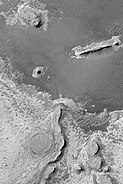
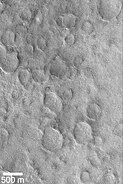







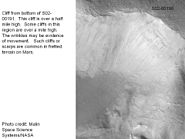

















![Mars Global Surveyor 1.jpg (109 KB) Template:Chem geysers]], taken by Mars Global Surveyor and released on 16 October 2000.](https://upload.wikimedia.org/wikipedia/commons/thumb/9/9f/Mars_Global_Surveyor_1.jpg/110px-Mars_Global_Surveyor_1.jpg)










